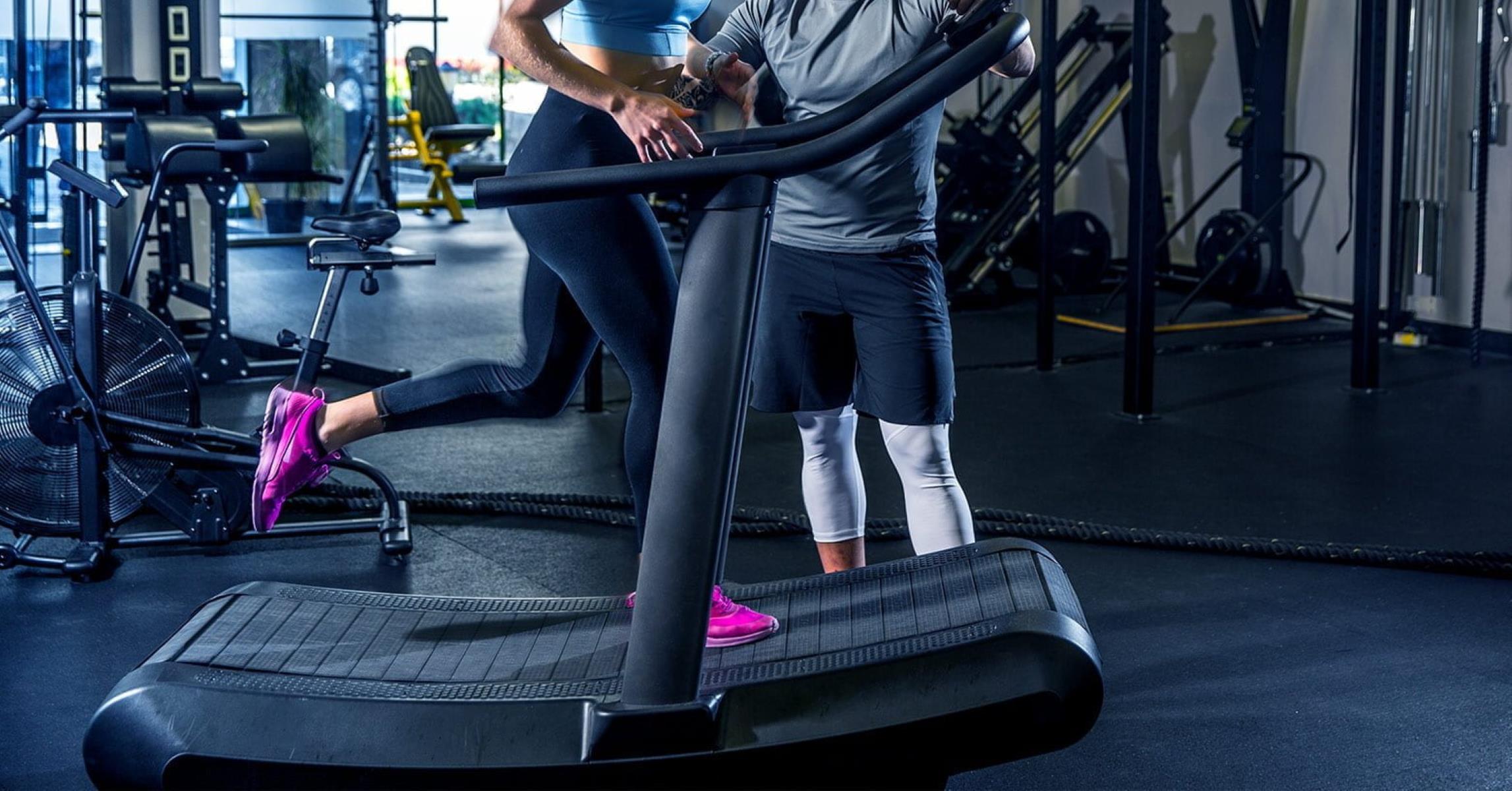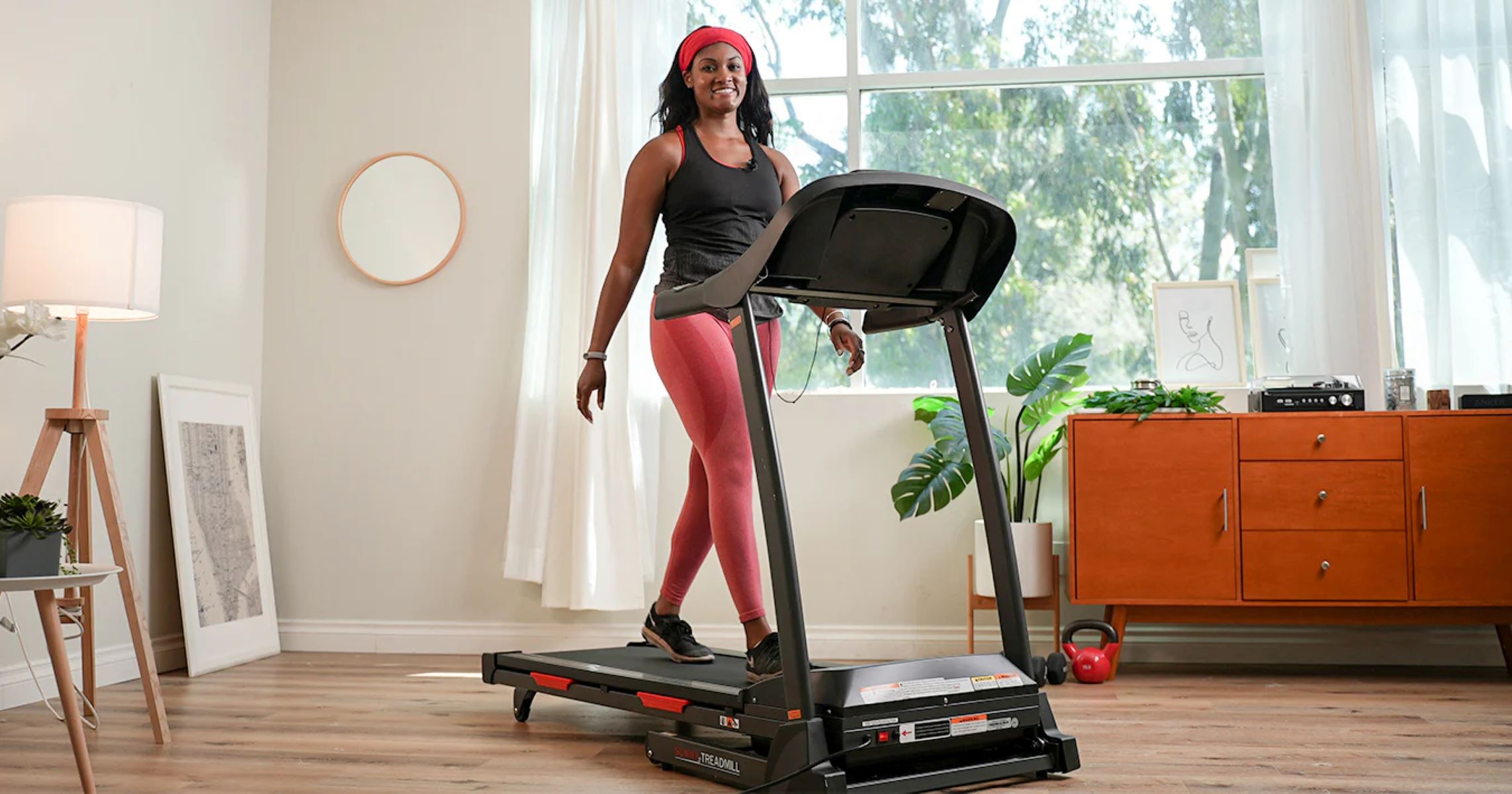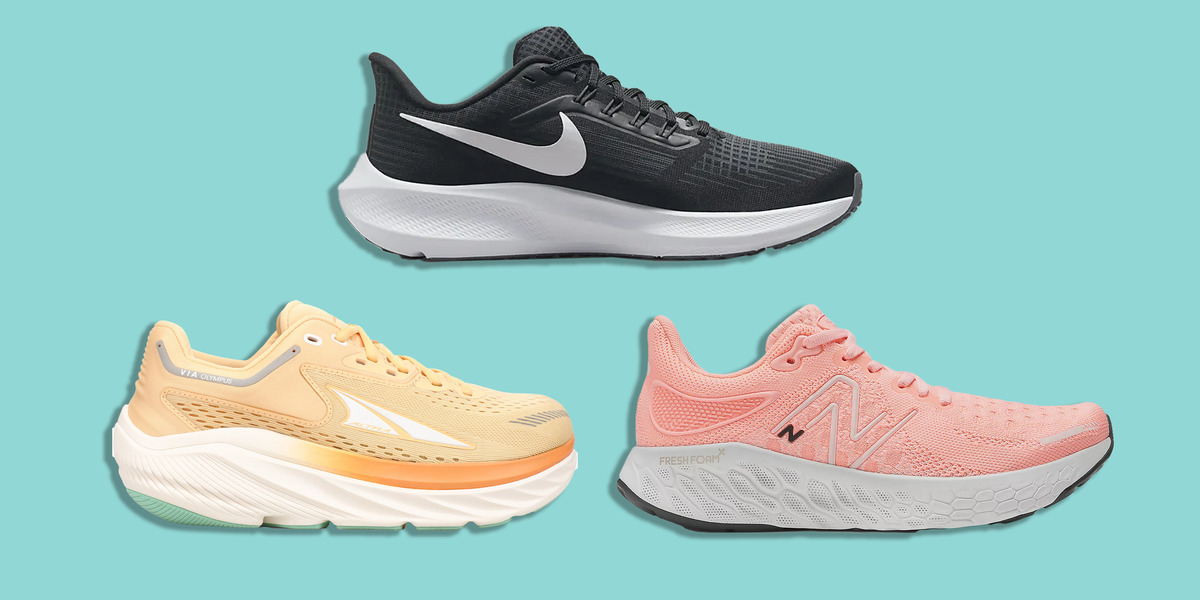

Featured
How To Use Curved Treadmill
Modified: March 2, 2024
Discover the benefits of using a curved treadmill with our featured guide on how to maximize your workouts and achieve your fitness goals.
Introduction
Welcome to the world of curved treadmills! These innovative exercise machines have gained popularity in recent years due to their unique design and numerous benefits. Unlike traditional flat treadmills, curved treadmills offer a curved running surface that mimics the natural movement of running outdoors. This design not only provides a more challenging workout, but also promotes better running form and reduces the risk of injuries.
In this article, we will explore the various aspects of using a curved treadmill, including its benefits, getting started, correct running form, adjusting speed and incline, recommended workouts, advanced techniques and training methods, safety precautions, and maintenance tips. Whether you are a seasoned runner or someone just starting their fitness journey, this guide will equip you with the knowledge and insights you need to make the most out of your curved treadmill workouts.
Curved treadmills offer a dynamic and engaging way to elevate your cardiovascular fitness, build strength, and burn calories. The continuous curve of the running surface requires more effort from your lower body muscles, including your quads, hamstrings, and glutes, compared to running on a flat surface. This leads to a more intense workout and faster calorie burn.
Furthermore, the curved design of the treadmill encourages proper running form. As you run on a curved treadmill, you naturally lean forward and land on the balls of your feet, which promotes a midfoot strike instead of a heel strike. This alignment helps reduce the impact on your joints, particularly the knees and ankles, and minimizes the risk of common running injuries.
Are you ready to take your running to the next level? Let’s dive deeper into the benefits of a curved treadmill and discover how to make the most of this innovative fitness equipment.
Benefits of a Curved Treadmill
A curved treadmill offers a range of advantages that can greatly enhance your running experience and overall fitness journey. Here are some key benefits:
- Increased Calorie Burn: The curved design of the treadmill requires more effort from your muscles, resulting in a higher calorie burn compared to traditional flat treadmills. This can help you achieve your weight loss or maintenance goals more efficiently.
- Improved Running Form: Running on a curved treadmill promotes a natural running gait. The curve encourages you to lean forward slightly while landing on the balls of your feet, leading to a midfoot strike. This fosters better running mechanics and reduces the risk of injuries.
- Greater Muscle Engagement: The continuous curve of the treadmill engages more muscles than a flat surface. As you run, your quads, hamstrings, glutes, and calves all work harder to propel you forward. This helps strengthen and tone your lower body muscles.
- Joint-Friendly Workout: The curved design of the treadmill reduces the impact on your joints, particularly the knees and ankles. This makes running on a curved treadmill a safer option for individuals with joint sensitivities or previous injuries.
- Versatile Training Ability: Curved treadmills offer a wide range of training options. You can run, sprint, perform intervals, and even perform various functional exercises like sled pushes and sled drags. This versatility allows you to customize your workouts and target specific fitness goals.
- Real-Life Running Simulation: Running on a curved treadmill closely mimics the experience of outdoor running. The curved surface provides a more realistic and dynamic running feel, allowing you to prepare your body for outdoor runs, races, or sporting events.
- Space Efficiency: Curved treadmills are generally more compact than traditional treadmills, making them an ideal choice for individuals with limited workout space at home or in a gym setting.
- Motivating and Engaging Workouts: The unique design and challenging nature of curved treadmills can make your workouts more engaging and enjoyable. The constant feedback of working against the curve can help you stay focused, motivated, and push your limits.
With these numerous benefits, it’s clear why curved treadmills have become increasingly popular among fitness enthusiasts. Whether you’re looking to improve your running performance, burn calories, or simply enjoy a more dynamic and effective workout, a curved treadmill can be a valuable addition to your fitness routine.
Getting Started
If you’ve just purchased or are planning to use a curved treadmill for the first time, it’s important to start off on the right foot. Here are some essential tips for getting started:
- Warm up: Before hopping on the curved treadmill, make sure to properly warm up your body. This can include a combination of dynamic stretches, light jogging, or other cardiovascular exercises. Warming up helps prepare your muscles and joints for the upcoming workout.
- Adjust the settings: Familiarize yourself with the settings and features of the curved treadmill. Adjust the incline and speed to a comfortable level before starting your workout. Aim to maintain a pace that is challenging but allows you to maintain proper form throughout.
- Start slow: If you’re new to curved treadmills or have limited experience with running, it’s essential to start slow and gradually increase your speed, intensity, and duration over time. This allows your body to adapt to the new movements and build stamina without risking injury.
- Focus on proper form: Pay close attention to your running form while using a curved treadmill. Keep your posture tall, engage your core, and lean slightly forward from the ankles. Land on the balls of your feet and push off using your entire foot. Avoid excessive leaning back or overstriding.
- Listen to your body: It’s important to listen to your body and respect its limits. If you experience any pain, discomfort, or excessive fatigue, consider taking a break or adjusting your intensity. Push yourself, but not to the point of compromising your safety and well-being.
- Mix up your workouts: To keep your workouts interesting and challenging, incorporate a variety of workout formats. This can include steady-state runs, interval training, hill sprints, or mixing in other exercises like lunges or push-ups. Experiment with different workout styles to find what works best for you.
- Cool down: After completing your curved treadmill workout, don’t forget to cool down properly. Gradually decrease the speed and incline, and finish with some static stretching to help with muscle recovery and prevent post-workout soreness.
- Stay hydrated: Hydration is crucial during any exercise session. Make sure to drink plenty of water before, during, and after your curved treadmill workouts to maintain optimal performance and support your body’s recovery.
By following these tips, you can ensure a smooth and effective start to your curved treadmill training. Remember, consistency and gradual progression are key to maximizing your results and minimizing the risk of injury. Happy running!
Correct Running Form on a Curved Treadmill
Proper running form is essential for getting the most out of your curved treadmill workouts. Here are some key tips to help you maintain correct running form on a curved treadmill:
- Posture: Keep your posture tall and upright while running on a curved treadmill. Avoid slouching or leaning back, as this can negatively impact your form and lead to inefficient running mechanics.
- Foot Placement: Land on the balls of your feet when running on the curved treadmill. This promotes a midfoot strike and helps in maintaining a natural running gait. Avoid landing on your heels, as it can increase the risk of injuries and reduce your running efficiency.
- Stride Length: Aim for a comfortable and natural stride length. Avoid overstriding by taking long strides, as it can cause excessive stress on your joints and muscles. Instead, focus on a mid-range stride length that allows for proper hip extension and optimal power generation.
- Arm Swing: Your arms play a crucial role in maintaining balance and generating forward momentum. Swing your arms naturally, keeping them at a 90-degree angle. Avoid crossing your arms in front of your body, as it can disrupt your balance and impede your running form.
- Core Engagement: Engage your core muscles by drawing your belly button towards your spine. This helps stabilize your torso and maintain proper alignment as you run on the curved treadmill.
- Breathing: Focus on breathing deeply and rhythmically to supply your muscles with an adequate oxygen supply. Inhale through your nose and exhale through your mouth, allowing your breathing to naturally match your running pace.
- Head Position: Keep your head aligned with your spine and gaze forward. Avoid looking down at your feet or staring straight ahead, as it can disrupt your balance and hinder your running form.
- Relaxation: Maintain a relaxed and loose upper body while running. Tension in your shoulders, arms, and hands can waste energy and negatively impact your efficiency. Stay relaxed and let your body move naturally with the rhythm of your running.
Practicing and maintaining correct running form on a curved treadmill will not only help you optimize your workout but also minimize the risk of injuries. Remember, it takes time and practice to develop good running form, so be patient and focus on gradual improvements. Consider recording yourself or seeking guidance from a fitness professional to further refine your technique. With practice, running on a curved treadmill will feel natural and allow you to reap the full benefits of this unique training tool.
Adjusting Speed and Incline
Adjusting the speed and incline of your curved treadmill can greatly enhance your workouts and help you achieve your fitness goals. Here are some tips for effectively adjusting these settings:
- Start with a Comfortable Speed: Begin your workout at a speed that allows you to maintain proper running form and feel comfortable. As you warm up and get into the rhythm, gradually increase the speed to challenge yourself.
- Increase Speed Gradually: When increasing the speed on a curved treadmill, do so gradually. Sudden changes in speed can disrupt your running form and increase the risk of injury. Aim to increase your speed in small increments, allowing your body to adjust and adapt.
- Use Interval Training: Interval training is an effective way to vary your workout intensity and keep your body challenged. Alternate between periods of higher speed and recovery periods at a slower pace. This not only improves your cardiovascular fitness but also helps burn more calories.
- Experiment with Incline: Adjusting the incline on a curved treadmill can further intensify your workouts and target different muscle groups. Increase the incline to simulate running uphill, which engages your glutes, hamstrings, and calves more. Gradually increase the incline as your fitness level improves.
- Listen to Your Body: Pay attention to how your body responds to changes in speed and incline. If you feel any discomfort or excessive fatigue, consider reducing the intensity or taking a break. It’s important to challenge yourself, but not at the expense of your safety and well-being.
- Make Adjustments Based on Goals: Depending on your fitness goals, you may need to adjust the speed and incline differently. For endurance training, focus on longer runs at a moderate pace. For speed and interval training, increase the speed and include shorter bursts of high-intensity running.
- Monitor Your Heart Rate: If you have a heart rate monitor, use it to gauge your effort level and ensure you’re working within your target heart rate zone. This can help you optimize your workouts and ensure you’re getting the most out of your time on the curved treadmill.
- Keep a Record: Keep a workout log or use a fitness app to track your speed, incline, and duration during your treadmill sessions. This allows you to monitor your progress, set goals, and make incremental adjustments to continue challenging yourself.
Remember, the speed and incline settings should be personalized to your fitness level and goals. Experiment with different settings, listen to your body, and make adjustments accordingly. By effectively adjusting the speed and incline on your curved treadmill, you can keep your workouts challenging, varied, and tailored to your needs.
Recommended Workouts on a Curved Treadmill
A curved treadmill offers a variety of workout options to cater to different fitness goals and preferences. Here are some recommended workouts to try on your curved treadmill:
- Steady-State Run: This is a classic endurance-building workout. Set a moderate pace and aim to maintain it for an extended period of time, typically 20-60 minutes. Focus on steady breathing and proper form. This workout helps improve cardiovascular fitness and builds endurance.
- Interval Training: Interval workouts involve alternating between high-intensity bursts and recovery periods. For example, run at a challenging pace for 1-2 minutes, then recover at a slower pace for 1-2 minutes. Repeat this pattern for multiple sets. Interval training boosts cardiovascular fitness, burns calories, and improves speed.
- Hill Training: Adjust the incline on your curved treadmill to simulate uphill running. Begin with a gentle incline and gradually increase it over time. Run at a moderate pace while focusing on engaging your glutes, hamstrings, and calves. This workout strengthens your lower body and improves climbing abilities.
- Speed Intervals: This workout focuses on increasing your running speed. Alternate between short bursts of maximum effort sprinting and recovery periods. For example, sprint for 30 seconds, then recover for 1-2 minutes. Repeat for several sets. Speed intervals enhance speed, explosive power, and anaerobic capacity.
- Pyramid Workout: This challenging workout involves gradually increasing and then decreasing the intensity. Start with a warm-up period, then increase the speed or incline every minute for a designated period of time (e.g. 5 minutes). After reaching the peak intensity, reverse the pattern and gradually decrease the speed or incline back to the starting point.
- Functional Training: In addition to running, take advantage of the curved treadmill’s versatility by incorporating functional exercises. Perform exercises like sled pushes, sled drags, walking lunges, or lateral shuffles. These workouts engage more muscle groups and increase overall strength and power.
- Fartlek Training: Fartlek, meaning “speed play” in Swedish, involves mixing periods of faster and slower running without adhering to strict intervals. Incorporate spontaneous bursts of speed throughout your run, such as sprinting between lampposts or running faster on certain sections of the treadmill. This workout improves speed, endurance, and mental toughness.
- Pre-Programmed Workouts: Many curved treadmills offer pre-programmed workouts with various intensities, inclines, and durations. These workouts are designed to challenge your fitness level and provide a structured training session. Explore the pre-programmed options on your treadmill to add variety to your workouts.
Remember to warm up before each workout and cool down afterward. Hydrate properly and listen to your body. Choose workouts that align with your current fitness level and gradually progress as your fitness improves. Mix and match different workouts to keep your routine engaging and challenging. Variety is key to avoid plateaus and keep your progress consistent.
Advanced Techniques and Training Methods
Once you have become accustomed to running on a curved treadmill and have mastered the basic workouts, you can take your training to the next level with advanced techniques and training methods. Here are some strategies to consider:
- Progressive Overload: Gradually increase the intensity, duration, or frequency of your workouts over time. This progressive overload principle helps to continually challenge your body and stimulate further improvements in strength, endurance, and performance.
- Tempo Runs: Tempo runs involve running at a comfortably hard pace, just below your maximum effort. Maintain this pace for a sustained period of time, typically 20-40 minutes. This workout enhances your lactate threshold, which is the point at which fatigue and muscle burn sets in.
- Long Runs: Incorporate longer runs into your training regimen to build endurance and mental toughness. Gradually increase your mileage during these runs, aiming to extend your distance over time. Long runs are especially beneficial for preparing for races or endurance events.
- High-Intensity Interval Training (HIIT): HIIT workouts involve short bursts of all-out effort followed by brief recovery periods. For example, sprint at your maximum speed for 20 seconds, then recover for 10 seconds. Repeat this cycle for several sets. HIIT improves cardiovascular fitness, burns calories, and can be a time-efficient way to train.
- Running Drills: Incorporate running drills into your warm-up routine or as separate training sessions. These drills, such as high knees, butt kicks, or bounding, help improve running efficiency, stride length, and overall running technique.
- Interval Incline Training: Adjust the incline settings on your curved treadmill to create a more challenging incline interval workout. Alternate between periods of running at a moderate speed on a flat surface and running at a higher intensity on an elevated incline. This workout builds strength and power in your lower body muscles.
- Cross-Training: Supplement your curved treadmill workouts with other forms of exercise to enhance your overall fitness and prevent boredom. Include activities such as strength training, cycling, swimming, or yoga to improve muscular strength, flexibility, and overall balance.
- Periodization: Consider implementing a structured training plan that incorporates different phases of training, each with specific goals and intensities. This allows for proper rest and recovery and helps prevent overtraining. Consult with a qualified fitness professional or coach to design a periodized training program tailored to your needs.
As with any advanced training techniques, it’s important to progress gradually and listen to your body. Ensure that you maintain proper form and allow for adequate recovery between intense workouts. Incorporating these advanced techniques and training methods into your curved treadmill routine can take your fitness journey to new heights and help you achieve your performance goals.
Safety Precautions and Considerations
While curved treadmills offer a unique and effective way to enhance your running workouts, it’s important to prioritize safety. Here are some essential safety precautions and considerations to keep in mind:
- Proper Footwear: Wear appropriate running shoes that provide adequate support, cushioning, and stability. This helps protect your feet and ankles and reduces the risk of injuries. Replace worn-out shoes regularly to maintain optimal performance.
- Warm-Up and Cool Down: Always warm up your body before starting a curved treadmill workout. This can include dynamic stretches and light cardio exercises to prepare your muscles and joints. Similarly, cool down with static stretches to promote muscle recovery and prevent stiffness.
- Gradual Progression: Avoid suddenly increasing the intensity or duration of your workouts. Gradually progress your workouts over time to allow your body to adapt and reduce the risk of overuse or strain injuries. Listen to your body’s signals and adjust your training accordingly.
- Hydration: Stay properly hydrated during your workouts by drinking water before, during, and after your treadmill sessions. Maintaining hydration supports optimal performance and helps regulate your body temperature.
- Monitor Heart Rate: If you have a heart rate monitor, use it to ensure you’re working within your target heart rate zone. This helps you gauge the intensity of your workout and prevents excessive strain on your cardiovascular system.
- Emergency Stop Button: Familiarize yourself with the location and function of the emergency stop button on the curved treadmill. Be prepared to use it in case of any issues or emergencies.
- Keep a Clear Space: Ensure that there is ample space around the treadmill for safe movement. Remove any obstacles or tripping hazards to prevent accidents during your workouts.
- Use Safety Features: Most curved treadmills come with safety features such as handrails and automatic shut-off mechanisms. Familiarize yourself with these features and use them as needed for stability and safety.
- Listen to Your Body: Pay attention to any signs of pain, discomfort, or excessive fatigue. It’s important to listen to your body and take necessary breaks or modify your workouts if needed. Push yourself, but not at the expense of your well-being.
- Consult a Professional: If you are new to running or have any pre-existing health conditions, consider consulting with a fitness professional or healthcare provider. They can provide guidance on proper technique, training plans, and any specific considerations based on your individual needs.
Implementing these safety precautions and considerations will help ensure a safe and enjoyable experience while using a curved treadmill. Prioritizing safety allows you to focus on maximizing your workouts and reaching your fitness goals with confidence. Remember, taking care of your body is paramount to long-term success.
Maintenance and Care for Your Curved Treadmill
Regular maintenance and care are essential to keep your curved treadmill in optimal condition and prolong its lifespan. Here are some key maintenance tips to follow:
- Clean the Surface: Dust, sweat, and debris can accumulate on the running surface of your curved treadmill. Regularly wipe down the surface with a clean cloth or towel to remove any dirt or moisture. This helps maintain grip and prevents slipping.
- Lubricate the Belt: Check the manufacturer’s instructions for your curved treadmill model regarding belt lubrication. Periodically lubricate the belt to minimize friction and ensure smooth operation. Use a silicone-based lubricant recommended specifically for treadmills.
- Tighten Bolts and Screws: Regularly inspect the bolts and screws on your curved treadmill to ensure they are securely tightened. Loose bolts can compromise the stability and safety of the machine. Refer to the user manual for specific instructions on tightening the bolts.
- Check the Tension: The running surface should have a slight tension to provide the proper resistance during your workouts. If the belt feels loose or saggy, refer to the user manual to adjust the tension. An overly tight or loose belt can affect your stride and increase the risk of injury.
- Monitor Electronics: Keep an eye on the electronic components of your curved treadmill. If you notice any unusual behavior, such as flickering displays or malfunctioning buttons, contact the manufacturer or a professional technician for assistance.
- Protect from Moisture: Keep your curved treadmill away from moisture-prone areas such as bathrooms or basements. Avoid placing drinks or water bottles directly on the treadmill console to prevent liquid spills. Moisture can damage the electronic components and cause malfunctions.
- Cover or Store Properly: If your curved treadmill is not in use for an extended period, consider covering it with a protective cover to prevent dust accumulation. If you need to store it, follow the manufacturer’s instructions for proper disassembly and storage to avoid any damage.
- Follow User Manual Guidelines: Read and understand the user manual that comes with your curved treadmill. It provides important information on proper use, maintenance procedures, and troubleshooting. Adhering to the manufacturer’s guidelines ensures the longevity and safe operation of your treadmill.
- Professional Maintenance: Consider scheduling regular professional maintenance for your curved treadmill. Professional technicians can inspect the machine, make any necessary adjustments, and ensure that all components are working correctly. This helps identify potential issues early on and prolongs the lifespan of your equipment.
- Use with Care: Finally, always use your curved treadmill with care and follow proper usage guidelines. Avoid stepping on or off the running surface while the treadmill is in motion. Use the handrails for stability, but avoid leaning excessively on them during workouts.
By following these maintenance and care tips, you can keep your curved treadmill in excellent condition and ensure a smooth and safe workout experience. Regular maintenance not only prolongs the lifespan of your equipment but also ensures optimal performance, allowing you to make the most out of your treadmill workouts.
Conclusion
Using a curved treadmill can revolutionize your running workouts and take your fitness journey to new heights. With its unique design and numerous benefits, including increased calorie burn, improved running form, and greater muscle engagement, a curved treadmill offers a dynamic and effective way to enhance your cardiovascular fitness and build strength.
Throughout this article, we have explored the various aspects of using a curved treadmill, from understanding its benefits to adjusting speed and incline, and from recommended workouts to advanced techniques and safety precautions. By following these guidelines, you can optimize your curved treadmill workouts and maximize your results.
Remember to start slowly, focus on proper running form, and gradually increase the intensity and duration of your workouts. Listen to your body, take necessary breaks, and stay hydrated. Incorporate a variety of workouts, such as steady-state runs, interval training, hill sprints, and functional exercises, to keep your routine engaging and challenging.
Don’t forget about safety precautions and maintenance tips. Take care of your curved treadmill by cleaning the surface, lubricating the belt, and regularly checking the tension and tightening screws. Follow the user manual guidelines and consider professional maintenance when needed.
Whether you’re a beginner or an experienced runner, a curved treadmill can provide a fantastic fitness experience. Embrace the benefits, enjoy the versatility, and push yourself to reach new milestones. Lace up your shoes, step onto your curved treadmill, and let the journey toward improved fitness and performance begin!







